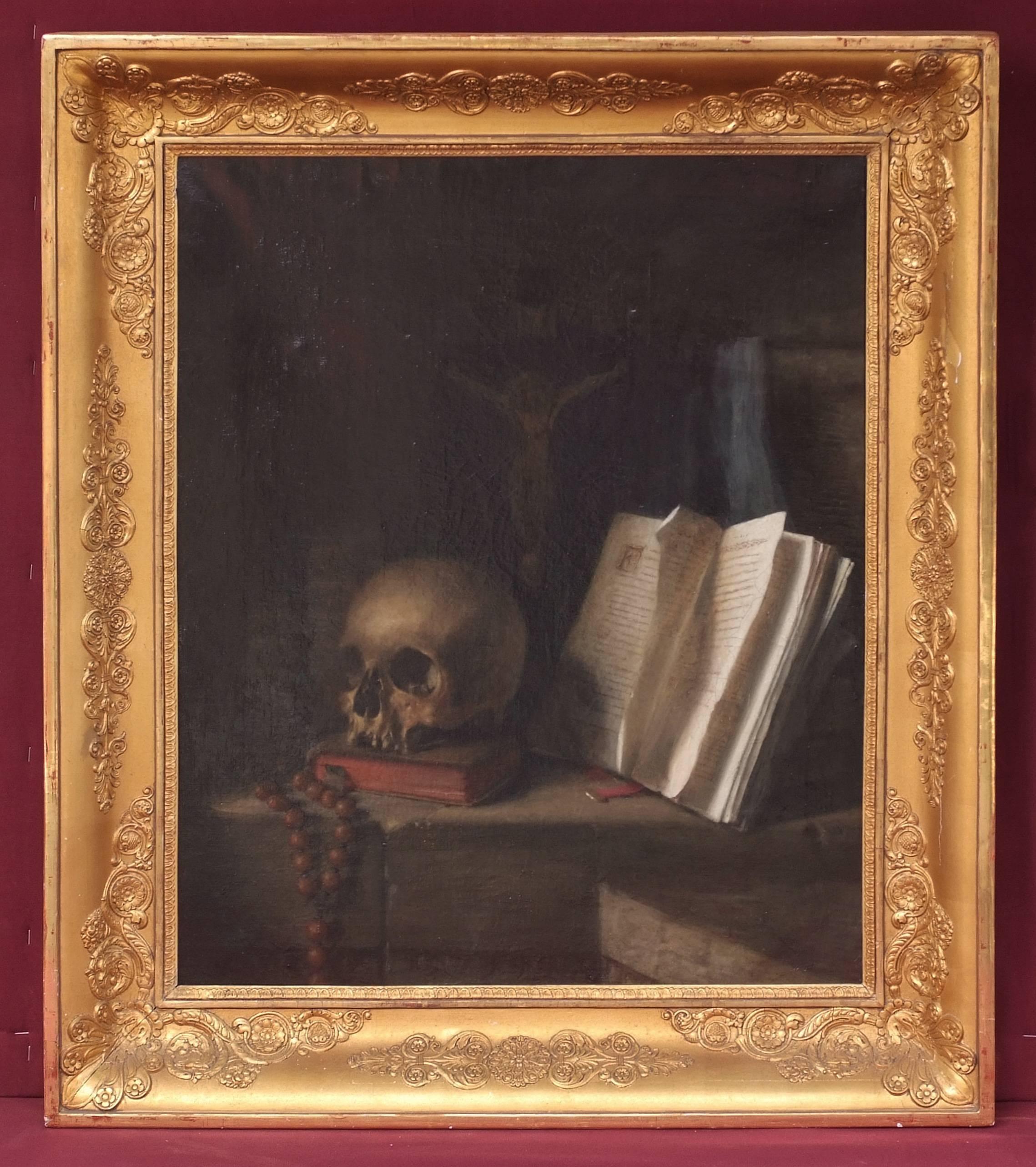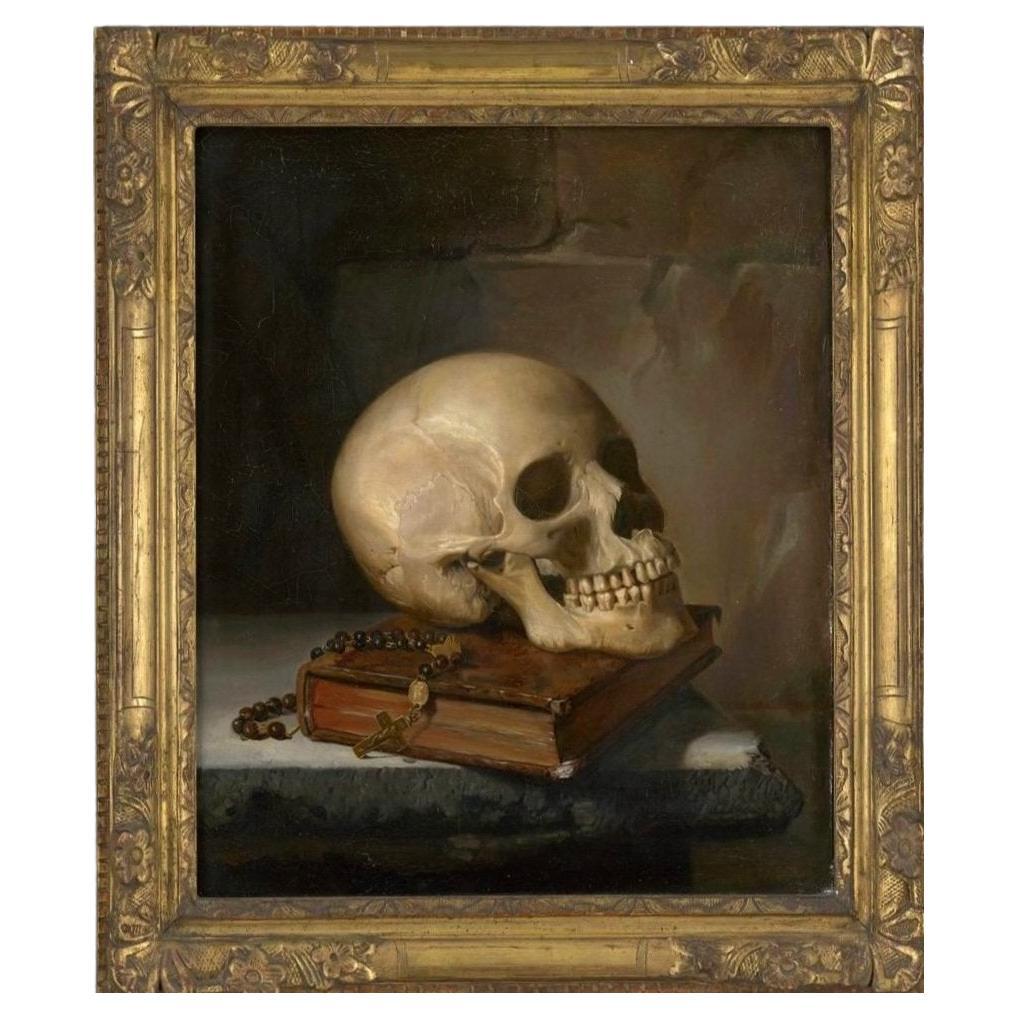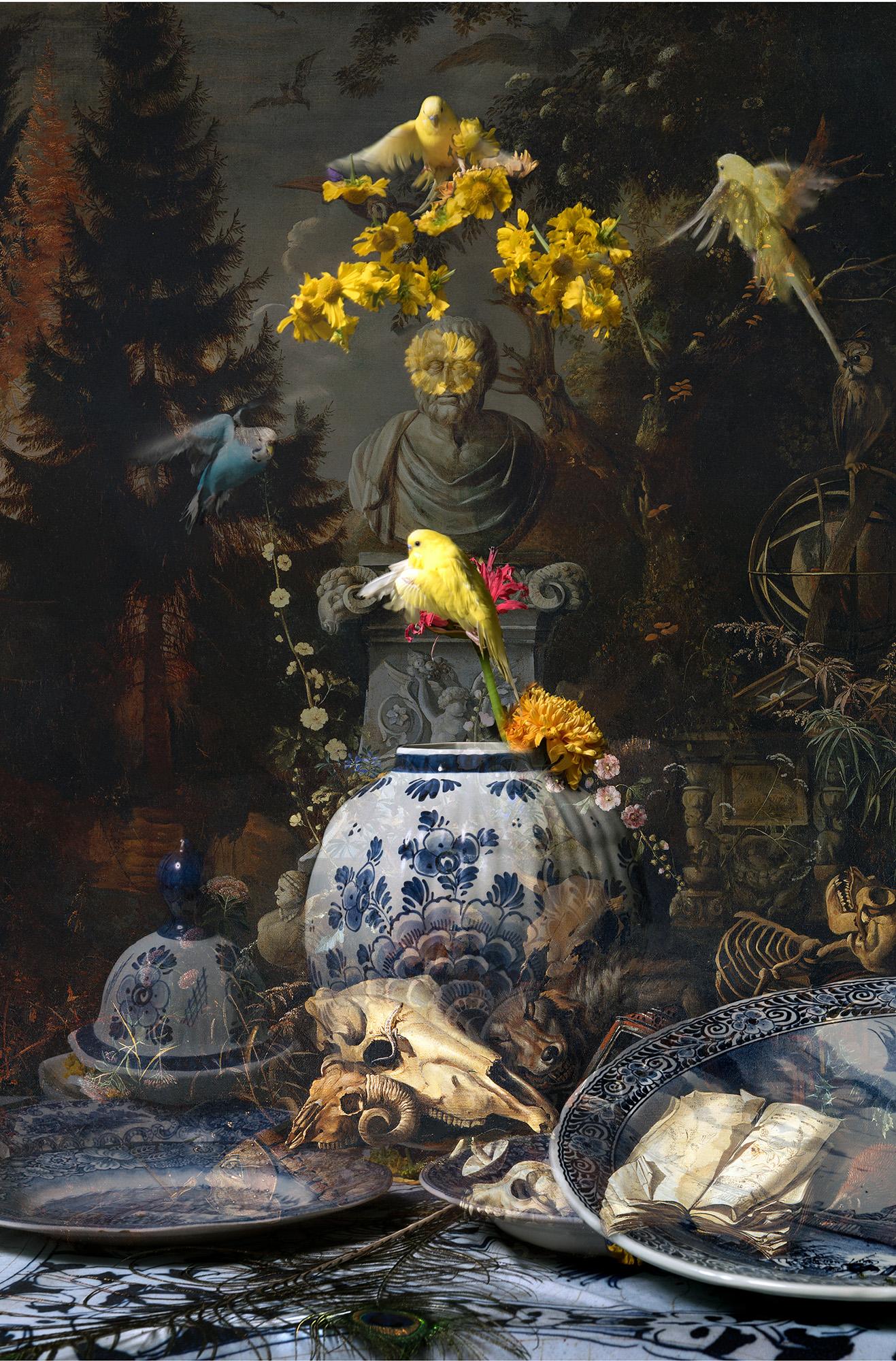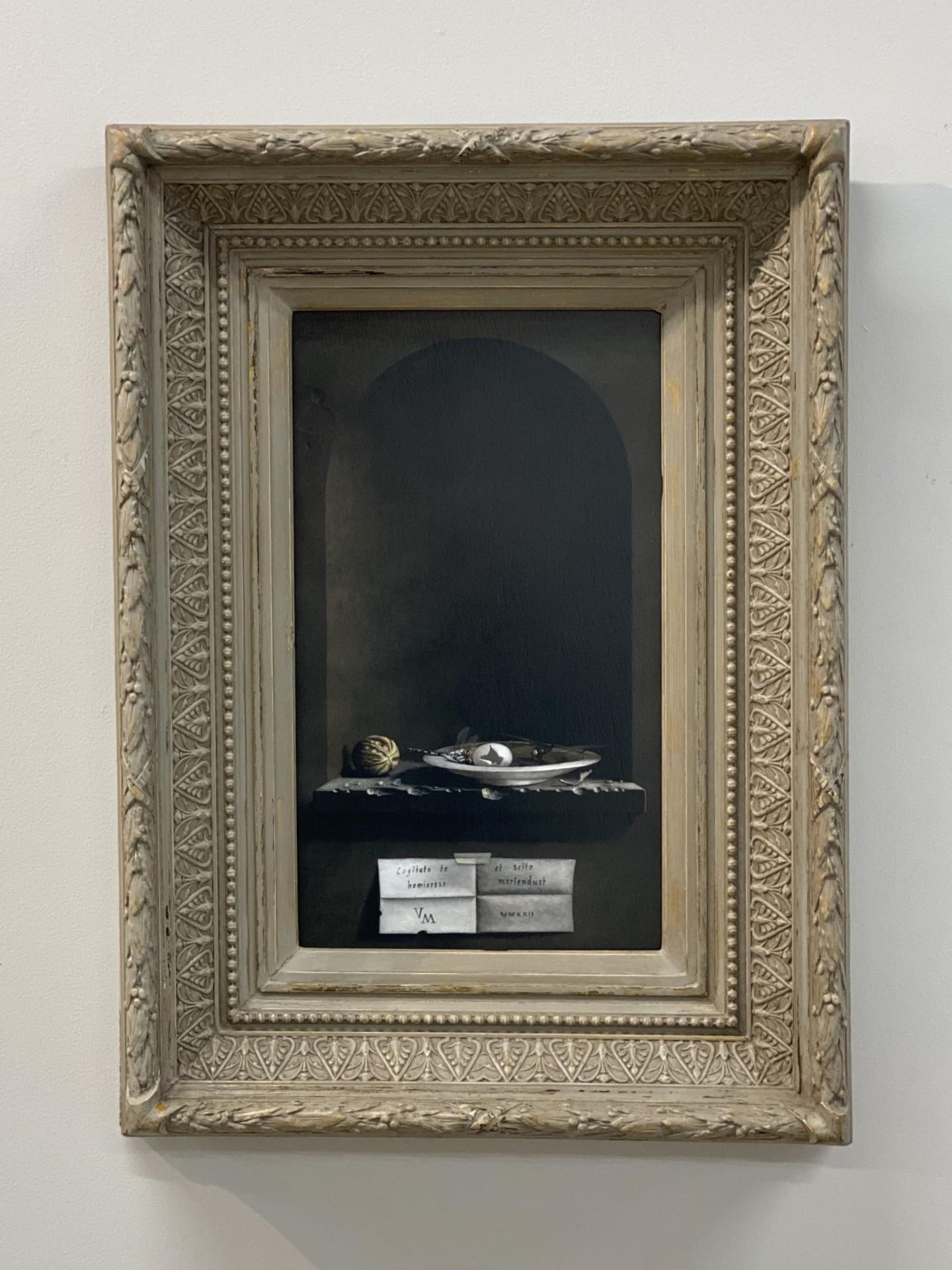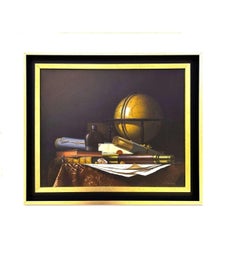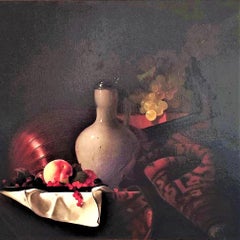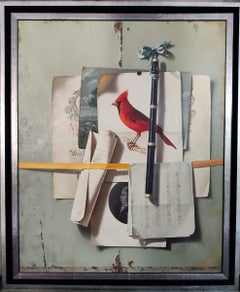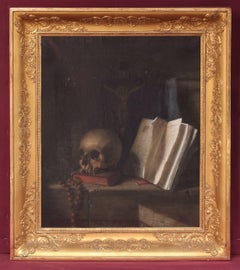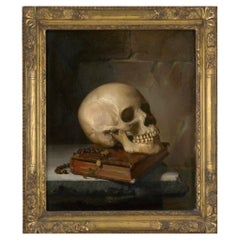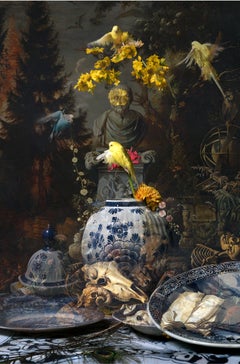Items Similar to Vanitas by Catherine Jansens (Born in 1949)
Want more images or videos?
Request additional images or videos from the seller
1 of 12
Catherine JansensVanitas by Catherine Jansens (Born in 1949)20th century
20th century
$8,914.70
£6,638.67
€7,500
CA$12,307.95
A$13,645.18
CHF 7,171.08
MX$166,994.65
NOK 89,559.44
SEK 84,060.50
DKK 57,102.50
About the Item
Catherine Jansens’ watercolour titled "Vanitas" is a compelling still life that delves into the theme of the transience of life and the inevitability of death—an idea traditionally explored in the Vanitas genre of art. This work continues Jansens' exploration of memory, time, and the symbolism of everyday objects, as seen in her previous works.
The composition of "Vanitas" is meticulously arranged, with each element purposefully placed to convey a deeper narrative. Central to the composition is an array of objects that symbolize the passage of time and the ephemerality of human existence. These might include items such as a skull, a candle, a clock, or a decaying flower, though the specific objects in Jansens' version may vary. What ties them together is their symbolic weight—each object contributing to the overarching theme of life’s fleeting nature.
In the tradition of Vanitas paintings, these objects are not just randomly chosen but are carefully selected to remind the viewer of the impermanence of worldly pleasures and the certainty of death. The arrangement is likely simple yet powerful, with objects set against a dark background that heightens the sense of mystery and introspection.
Jansens employs a restrained color palette, dominated by muted earth tones and deep shadows. This use of color not only enhances the somber mood of the piece but also reflects the theme of decay and impermanence. The watercolor medium, with its ability to blend and create soft transitions, is expertly used to depict the delicate textures and subtle variations in light and shadow. Jansens’ experience with hyperrealism in oil painting translates into her aquarelle work, where she captures the finest details with precision, even within the softer and more ethereal medium of watercolor.
The contrast between light and shadow in "Vanitas" is particularly striking, a technique that Jansens uses to draw attention to specific elements within the composition, emphasizing their symbolic significance. The subtle gradation of colors and the careful handling of light create a sense of depth and realism, making the objects appear almost tangible, yet still shrouded in a sense of mystery.
"Vanitas" by Jansens is deeply rooted in the theme of mortality, a central concept in the Vanitas tradition. The objects depicted serve as reminders of life’s temporary nature and the futility of material wealth and achievements in the face of death. This theme is consistent with Jansens’ broader artistic exploration of memory and the passage of time, as seen in her other works like "Waterman."
By choosing to work in aquarelle, Jansens adds an additional layer of meaning to the piece. The watercolor medium, known for its fluidity and unpredictability, mirrors the theme of impermanence—just as watercolors can shift and change with the slightest touch, so too can life’s circumstances. This choice of medium, combined with the Vanitas theme, makes the work not only a visual representation of mortality but also a reflection on the transient nature of art itself.
Catherine Jansens' "Vanitas" is a masterful aquarelle that merges technical skill with profound thematic depth. Through her expert use of composition, color, and light, Jansens invites the viewer to contemplate the fleeting nature of life and the inevitability of death. The work is a continuation of her exploration into memory and time, using "found objects" and everyday items to create a narrative that resonates on both a personal and universal level. Jansens' "Vanitas" is a poignant reminder of the delicate balance between life and death, captured with the precision and emotional resonance that defines her artistic legacy.
Biography
Catherine Jansens, born in 1949 in Marcq-en-Barœul, France, is a painter whose journey through the artistic landscape reflects both personal and technical evolution. Initially trained in graphic arts and fine arts at the École des Beaux-Arts in Lille, she began her career as a hyperrealist painter, working with oil on canvas. Her early works were characterized by meticulous detail, capturing the essence of reality with an almost photographic precision. However, an allergy to oil paints forced her to abandon this medium, leading to a significant shift in her artistic approach.
Undeterred by this challenge, Jansens transitioned to the aquarelle (watercolor) technique, bringing with her the precision and realism that had defined her oil paintings. This new medium allowed her to continue exploring the delicate interplay of light and shadow, now rendered with the soft, translucent quality that watercolors afford. Jansens also adopted the use of the camera obscura, an optical device that has been used by artists for centuries to project an image onto a surface, which she then meticulously traces or references. This technique enables her to maintain the ultra-realistic detail that has become a hallmark of her work.
Jansens' art is deeply personal, often centered around "found objects" that she rediscovered in the attic of her parental home following her mother’s death. These objects, remembered from her youth, serve as poignant reminders of the passage of time and the act of remembering. Through her still lifes, Jansens transforms these everyday items into vessels of memory, laden with emotional significance. Her compositions, whether depicting a model airplane resting on a navigation map or a globe placed beside a historical chart, invite viewers to contemplate the transient nature of life and the enduring power of memory.
Her artistic output has been widely recognized in exhibitions across France, Belgium, and Switzerland. Notable solo exhibitions include those at Galerie Varnier in Paris, Galerie Michel Voakaer in Brussels, and Gallery Sergiane Cauwel in Lille. Her work is held in prestigious public collections such as the FRAC de Picardie, the Conseil Général du Nord, and the Palais des Beaux-Arts in Lille, cementing her legacy as a significant figure in contemporary art.
Currently residing in the Eastern Pyrenees, Jansens continues to draw inspiration from the natural beauty of her surroundings, while her work remains rooted in the themes of memory, time, and the emotional resonance of the objects she paints. Her ability to convey these themes with technical brilliance and emotional depth ensures that her art resonates with a wide audience, making her a lasting and influential presence in the art world.
- Creator:Catherine Jansens (1949, French)
- Creation Year:20th century
- Dimensions:Height: 27.56 in (70.01 cm)Width: 33.46 in (84.99 cm)Depth: 1.97 in (5.01 cm)
- Medium:
- Period:
- Condition:
- Gallery Location:Gent, BE
- Reference Number:1stDibs: LU2140215054492
About the Seller
5.0
Vetted Professional Seller
Every seller passes strict standards for authenticity and reliability
Established in 2018
1stDibs seller since 2022
5 sales on 1stDibs
Typical response time: 2 hours
- ShippingRetrieving quote...Shipping from: Gent, Belgium
- Return Policy
Authenticity Guarantee
In the unlikely event there’s an issue with an item’s authenticity, contact us within 1 year for a full refund. DetailsMoney-Back Guarantee
If your item is not as described, is damaged in transit, or does not arrive, contact us within 7 days for a full refund. Details24-Hour Cancellation
You have a 24-hour grace period in which to reconsider your purchase, with no questions asked.Vetted Professional Sellers
Our world-class sellers must adhere to strict standards for service and quality, maintaining the integrity of our listings.Price-Match Guarantee
If you find that a seller listed the same item for a lower price elsewhere, we’ll match it.Trusted Global Delivery
Our best-in-class carrier network provides specialized shipping options worldwide, including custom delivery.More From This Seller
View AllStill Life with Globe, Books and Telescope, Oil on canvas by Jean Grimal (1942
By Jean Grimal
Located in Gent, VOV
In this masterfully executed trompe-l'œil, Jean Grimal displays his exceptional command of light, material rendering and illusionistic composition. The canvas presents a still life f...
Category
Late 20th Century Realist Still-life Paintings
Materials
Oil
Still-Life with a Viola da Gambe
By Jean Grimal
Located in Gent, VOV
Artist: Jean Grimal (1942-1998)
Period: 20th century
Condition: Excellent condition
Material: Oil painting
Length: 69 cm
Height: 58 cm
Signed Under Right
Category
Late 20th Century Realist Still-life Paintings
Materials
Oil
$7,559 Sale Price
20% Off
Still Life with Flute and Red Cardinal, Oil painting on canvas by Jean Grimal
Located in Gent, VOV
This captivating trompe-lœil painting showcases Jean Grimal’s extraordinary mastery of illusion. A vivid red cardinal, a black wooden flute, curling manuscripts and brittle music she...
Category
Late 20th Century Still-life Paintings
Materials
Oil
Still Life with Flute and Red Cardinal, Oil painting on canvas by Jean Grimal (1
By Jean Grimal
Located in Gent, VOV
This captivating trompe-lœil painting showcases Jean Grimal’s extraordinary mastery of illusion. A vivid red cardinal, a black wooden flute, curling manuscripts and brittle music she...
Category
Late 20th Century Realist Still-life Paintings
Materials
Oil
Still life with a Chinese bowl by Jean Grimal
By Jean Grimal
Located in Gent, VOV
Jean Grimal is a true 20th century discovery. This breathtaking piece is a gorgeous example of his mastery as an artist. He beautifully creates chiaroscuro in this painting. The way the light touches the edges of the Chinese bowl and the grapes is an example of his skill in representing light.
Jean Grimal (1942-1998) was born in the town of Tulle, France in 1942. Jean’s family moved to Paris when he was 8 years of age. After receiving a classical French education with studies in Latin and Greek, Jean Grimal entered the University to receive his Baccalaureate. He then attended Claude Barnard School for three years, when he received his Art Degree. Upon completion Grimal taught art for seven years. As Grimal’s own interest in formal painting and art began to possess him, the artist’s destiny changed.
In 1967 Jean Grimal stepped aside from teaching and pursued a career in professional painting and working as an illustrator in advertising. As an advertising illustrator, Grimal worked with Lise Goldfard for more than 25 years at Studio 44 where they collaborated with major and important accounts, such as: Air France, Christofle, Peugeot, Lacoste, to name a few. At the same time he began presenting his formal paintings to galleries in Paris and Cannes, France and in London and Windsor, England. Much to his surprise, Grimal found that his paintings were sought after by major art galleries and collectors throughout Europe. After a number of years of being an important and successful art illustrator for these major accounts, he found himself having to choose between the two. Fortunately for collectors, he chose to dedicate his life to the classical style of painting. Jean looked at the simplest things in life through a microscope, where he could take the simplest object and depict the age of the fruit or the leaf.
Jean Grimal received great pleasure from his work and painted for over thirty years. As his style matured and became ever more perfect Jean Grimal truly reached the pinnacle of his career. The artist’s methods were particularly distinguished when measured against his peers. Grimal’s painting skill was distinctive and exceptional.
Jean Grimal was known for his realistic trompe l’oeil and still life paintings. The artist would carefully arrange the objects to form a satisfying composition. By painting every shadow, highlight, and reflection within each composition Grimal brought mundane subjects to life. His tight rendering combined with his attention to light and detail allowed him to blur the lines between illusion and reality, truly making his works one of a kind. Grimal’s trompe l’oeil paintings consist of intricate compositions of cards, envelopes, photographs, paper of different materials and weights, backs of canvases, images of other artists’ works, kitchen utensils, pistols, and more. Grimal had a talent for mastering these illusions that deceive the eye in his trompe l’oeil paintings.
No matter what genre Grimal was painting, tight, unperceivable brushwork characterizes his work. The artist painted every crease and crinkle, every shadow and highlight, every detail. By doing so, he was able to capture each individual surface texture of the objects in his paintings. Grimal was also fabulous at depicting light in his paintings- often contrasting strong lights with strong darks, creating chiaroscuro modeling.
His still life paintings are reminiscent of Dutch seventeenth century...
Category
Late 20th Century Realist Still-life Paintings
Materials
Canvas, Oil
Christian Valdemar Clausen+ Oil on canvas Interior
By Christian Valdemar Clausen
Located in Gent, VOV
The painting by Christian Valdemar Clausen of an intimate and cozy interior scene, likely depicting a well-furnished sitting room or parlor.
Christian Valdemar Clausen was known for...
Category
19th Century Realist Interior Paintings
Materials
Oil
You May Also Like
Painting 18th Century Vanitas Still Life Skull Religion Esotericism Occult
Located in Saint-Ouen, FR
Vanitas 18th century
French School
Oil on canvas
Old frame gilded with gold leaves
Dim canvas : 73 X 60 cm
Dim frame : 93 X 80 cm
Certificate of authenticity
Category
Late 18th Century Old Masters Still-life Paintings
Materials
Oil
Early 19th Century French School Vanitas Still Life Oil Painting on Canvas
Located in London, GB
Antique Vanitas Oil Painting, Antique Memento Mori Oil Painting, Antique Skull Oil Painting, Gothic Antique Painting, 19th Century Vanitas Still Life Oil Painting.
Early 19th Century French Vanitas Oil Painting on Canvas.
The Old Master Vanitas Still Life Painting depicts a skull, book and rosary.
Oil on canvas, lined. Unsigned.
In gold gilt period frame.
Very well painted, attractive & highly decorative Vanitas skull...
Category
Antique Early 19th Century French Gothic Paintings
Materials
Canvas, Wood, Giltwood, Paint
Vanitas with Seneca
By Hans Withoos
Located in New York City, NY
Fine art inkjet print on special paper rag
Ask us for framing options
Hans Withoos career spans more than twenty years worldwide. After graduating from the Art Academy. He specializ...
Category
2010s Contemporary Still-life Photography
Materials
Plexiglass, Color, Archival Pigment, Digital Pigment
Vanitas with Seneca
By Hans Withoos
Located in New York City, NY
HANS WITHOOS (Rotterdam, The Netherlands)
Vanitas with Seneca, 2016
60 x 40 inches - Edition of 9
Fine art inkjet print on special paper rag, on Dibond with a certified Liquid Gloss...
Category
2010s Contemporary Still-life Photography
Materials
Archival Pigment
Vanitas Oil Painting on Panel Still Life In Stock
By Victor Muller
Located in Utrecht, NL
Vanitas Oil Painting on Linen Canvas Still Life In Stock
Born in Den Helder, The Netherlands in 1976. Victor Muller is a young artist with a considerable and amazing oeuvre. He crea...
Category
21st Century and Contemporary Contemporary Figurative Paintings
Materials
Oil, Panel
Vanitas with Seneca by Hans Withoos
By Hans Withoos
Located in New York City, NY
Fine art inkjet print on special paper rag
Ask us for framing options
Hans Withoos career spans more than twenty years worldwide. After graduating from the Art Academy. He specializ...
Category
2010s Contemporary Still-life Photography
Materials
Plexiglass, Color, Archival Pigment, Digital Pigment
More Ways To Browse
Clock Clock By Humans
Clocks With Globe
Vintage Airplane Painting
Vintage Paris Map Framed
Vintage Oil Clock
Jansen Oil
Skull Mirror
Skull Candle
Vintage World Map Mirror
Jean Pierre Laurens
David Meredith
Andre Marchand
Cavailles Painting
Dorothy Southern
Gio Bellagio
Marinelli Italy
Oil Painting Still Life With Parrot
Artichoke Painting
